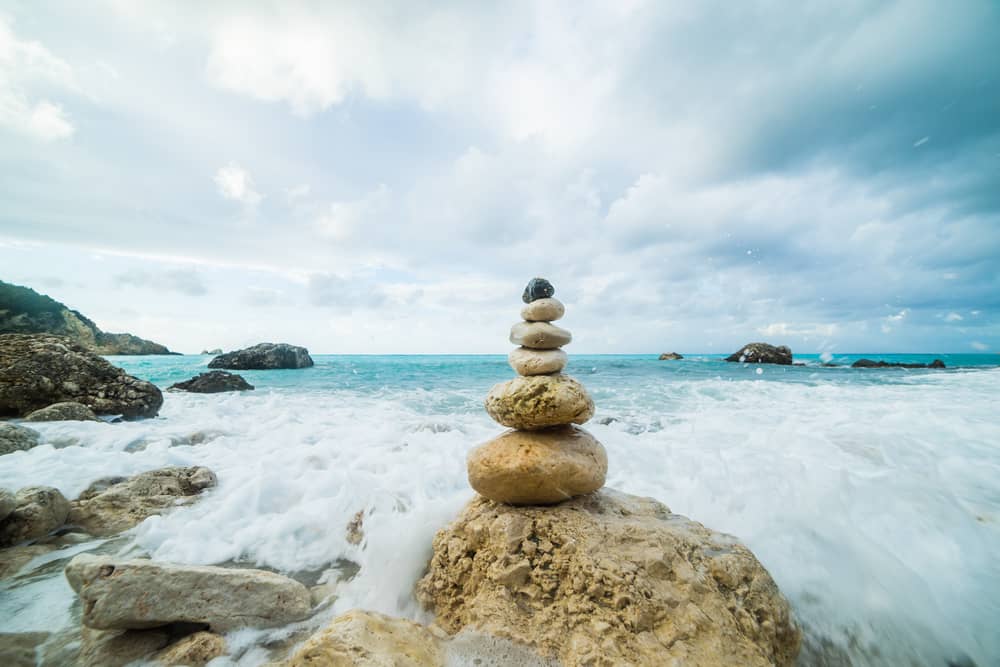
Meditation coach Emma Morrison is the go-to person for those…
In yoga, there are the Yamas and Niyamas. These are the ethical guidelines that inform one’s practice. One of these values is Svadhyaya.
Svadhyaya can be translated as “self-study.”
The word “sva” means “own,” “self,’ or “the human soul.” And Adhyaya means “lesson,” “lecture,” or “reading.” Therefore, Svadhyaya implies the study of oneself.
But Svadhyaya goes much deeper than that.
What Is Svadhyaya?

Svadhyaya reveals itself in traditional yogic teachings. But it can be a little difficult to understand. Try thinking of it this way.
Imagine the waves of the ocean.
Each wave travels across the surface of the sea. Each wave is an individual being. And each wave is distinguished by its location in space.
But the substance of every wave is the sea itself.
The waves and substance from which they arise are one and the same. Individual waves are a part of the sea. They appear and disappear. And that neither increases or decreases the immensity of water.
A wave is never separate from the ocean. But it has manifested on the ocean’s surface.
The premise of Svadhyaya is similar.
It is said that individual awareness can never separate from infinite consciousness. Individual minds have distinctive qualities, preferences, and colorings. But they are not entirely autonomous.
Each mind is a wave in the vast expanse of consciousness.
The aim of Svadhyaya is to bring the experience of immense consciousness into awareness. And the process of self-discovery in this way is Svadhyaya.
The Nature of the Self

Studying the self means recognizing our habits and thought processes. Through this, we realize how much of what we do and think is actually far from who we really are.
More often than not, we listen to ego.
Ego urges us to do things that do not always align with our true beliefs or intuition. And ego is ultimately what makes up our small “self.”
The small “self” is concerned with survival.
Usually, this entails getting everything that it wants in all situations. It has to prove itself to be the best despite whatever consequences may arise. And sometimes, those consequences leave us even worse off than before.
The small self judges, criticizes, fears, conditions, and doubts. It belittles and causes a division between us and our understanding of the true Self. The small self is the cause of the chitta vrittis or “fluctuations of the mind.”
But paying attention to the Self, we become more aware.
We notice things that we do to harm ourselves. We recognize those who serve us and those who bring us closer to ourselves. In this way, we are able to acknowledge our habits and thought processes. Then, we are brought closer to the process of “yoking” and “uniting” with our true Self.
Studying Scripture

Many yogic texts contain fascinating and inspiring pieces of writing. It is advised that dedicated students of yoga would benefit from reading them. But more so, a student must reflect upon these texts.
Take the time to delve into ancient wisdom.
Apply the practice of Svadhyaya to your modern-day life. Include studying scripture into your daily routine. Read and investigate the study of yoga.
This will bring you closer to self-realization.
Learn how to understanding and connect with yoga through research. Cultivate a curiosity about yoga off of the mat. In this way, you will cultivate your own practice of Svadhyaya.
Try spending time with the words of Buddha, Mooji, Krishna, or Ramana Maharshi. Pearls of truth can be found everywhere. Bathe in these words. They will express the truth and will help you to learn who you are.
This will also help you to learn what you are not.
Another important aspect of Svadhyaya is learning how to differentiate oneself. Even though we are all connected, we are all still distinct and unique. Recognizing those qualities in ourselves will help us to determine who we are and who we are not.
Svadhyaya On the Mat

During your yoga practice, try to study your habits on the mat. This can go a long way towards recognizing your habits off the mat.
The way in which we practice yoga reflects the way in which we practice life.
A person’s physical yoga practice often reveals more about them than they think. When on the mat, there is nowhere to hide. We are so used to the daily distractions of phones, chores, emails, and TV. But on the mat, none of those exist.
Instead, you have to pay attention during yoga.
This can be intimidating at first. But yoga practice is meant to reveal more about ourselves. It can reveal more about our problems and reflect how far from perfect we are.
Yoga is ultimately a great way to destroy ego. And in doing so, you will start to discover your true Self.
Study the Breath

Breath awareness is usually the first thing we do when starting our yoga practice. The breath tells us how we are. A short, shallow breath held high may signal that we are stressed or worried. It might tell us that we are about to physically push ourselves beyond our healthy limits.
If your breath resembles this, ask yourself why.
Is there a reason to be stressed or worried in this moment? Does it matter right now? Try asking yourself where you are holding tension.
Take a quick body scan. Examine your jaw, forehead, neck, shoulders, and upper back. These are common places where fear and worries can be stored.
When on the mat, become aware of what you can undo before you do anything else.
Ask yourself why this tension might be present. How often does it arise during practice? Use your ujjayi breath to explore the Self. Explore the thoughts that fill your head during practice.
Often times, being on the mat is the only time we give ourselves permission to stop. When we stop, the mind unloads millions of whirling thoughts.
But if you notice your mind becomes busy during yoga practice, do not block them out.
Instead, recognize and acknowledge these thoughts for what they are. This will teach you more about yourself. Recognize what thoughts enter the mind on a regular basis. This will help you cultivate a greater self-awareness that you can use both on and off the mat.
Practice Mantra Meditation

During mantra meditation, Svadhyaya is highly accessible. The silent inner recitation of mantras helps to anchor the mind to one thought. Soon, all sounds within your mind will become pregnant with the presence of the Self.
Traditionally, mantras are given to students for protection and guidance. Reciting mantras in the mind can also be a source of inner silence. When a mantra permeates the mind, it draws awareness inward.
At the same time, it makes outward aspects of the mind become silent.
Real silence in meditation is not the mind being emptied of sound. It is the mysterious experience of the mind being filled with the sound of mantra.
During your mantra meditation, learn to observe your breath through the nostrils. This will help you slow your breath. You will start to feel it warm and cool your body without effort.
Beginner students are usually given the mantra “soham.” This mantra helps to start the process of quieting the mind. It awakens the inner witness. And upon repeating soham, one can acquire direct, intuitive knowledge of the Self.
Thus, daily meditation allows for Svadhyaya to come to fulfillment.
After all, self-awareness is something that must be practiced daily.
Svadhyaya in Everyday Life

If you are looking for ways to practice Svadhyaya in your every day, start by paying attention. Ask yourself why you are doing what you are doing. Be fully present in your actions. And pay attention on a whole other level.
Questioning our actions is something we often avoid. Usually, it is a catalyst for change. And humans don’t generally like change.
But Svadhyaya comes down to recognizing one’s habits.
Self-awareness helps us discern between habits that come from the ego and habits that come from the true Self.
Practice taking a step back. Observe and question your actions. Then you can start to disentangle yourself from what is no longer serving you. This process will also help you realize what harmful things you are engaging in.
Svadhyaya asks us to be a witness to our own actions. But sometimes, that practice can go even deeper.
Try asking yourself, “Who am I?” throughout the day. Seek out the answer and see how it may change over time or depend on where you are. Additionally, you can ask, “Who is thinking these thoughts?” or “Who does this body belong to?” “Who eats this food? Who wakes up? Who goes to sleep? Who is reading this?”
Taking this deep-dive exploration might seem intimidating. But learning to recognize yourself as an objective party will help you gain a clearer perspective.
Final Thoughts

Svadhyaya is about observing yourself as a witness. It asks you to notice how you react when plans get changed. It encourages you to acknowledge the way you hold yourself.
Most importantly, these observations tell a story of who and how we are in this moment.
This is not always an easy task. And it is important to acknowledge how difficult this can be. Taking in the struggle to observe and identify oneself is an important part of the process.
The practice of Svadhyaya requires honesty. In order to truly cultivate self-awareness, we must view ourselves from an honest standpoint.
This process also involves discipline.
Taking an honest look at ourselves isn’t something we always like to do. We may have habits that are less than desirable. We may even recognize things we do not like about ourselves.
But non-violence reminds us to look upon ourselves without judgment or criticism.
It takes courage to seek out the things that disturb us. But the path to self-realization requires it.
There is a reason why Svadhyaya is a part of the Yamas and Niyamas. These ethical codes are not meant to be easy tasks to accomplish. They are meant to challenge you. And in doing so, they help you grow even stronger and more aware.
If you feel discouraged throughout your practice of Svadhyaya, acknowledge it.
Rather than beat yourself up, take a step back. Recognize the ways in which you harm yourself. Even small things like mentally discouraging ourselves can be considered a form of harm.
In this way, Svadhyaya just asks us to notice and listen. By listening, we can recognize what we need and what we don’t need. Rather than taking in everything as a means for survival, try acknowledging what you need to survive.
Survival is cutthroat. It is dire. And it is stark.
But living and thriving are so much more expansive.
Have you ever thought to yourself that maybe you’re not living fully? Svadhyaya helps you challenge those thoughts of doubt. Just by stepping back and paying attention, you can start to change your habits. Even small adjustments can help you feel that you are living more happily.
And in doing so, you are cultivating a more direct pathway to your truest Self.
Remember that self-realization is not a linear journey. There will be ups and downs. But that’s what makes it a journey. There are paths we must go down that we did not anticipate. And there are discoveries we make that are more rewarding than we previously thought.
Do not allow ego to drown out your truest Self.
It does not possess the very essence of you. And remember to approach everything with compassion and curiosity.
Svadhyaya can provide you the tools to live a healthier and happier life.
After all, it is better to approach the journey with curiosity and joy than with dread and fear.
What's Your Reaction?
Meditation coach Emma Morrison is the go-to person for those living in Salt Lake City, Utah, who need to release stress and tension or simply dive deeper into their meditation practice. In her writing, you’ll receive useful information on how to live a more fulfilling life.














